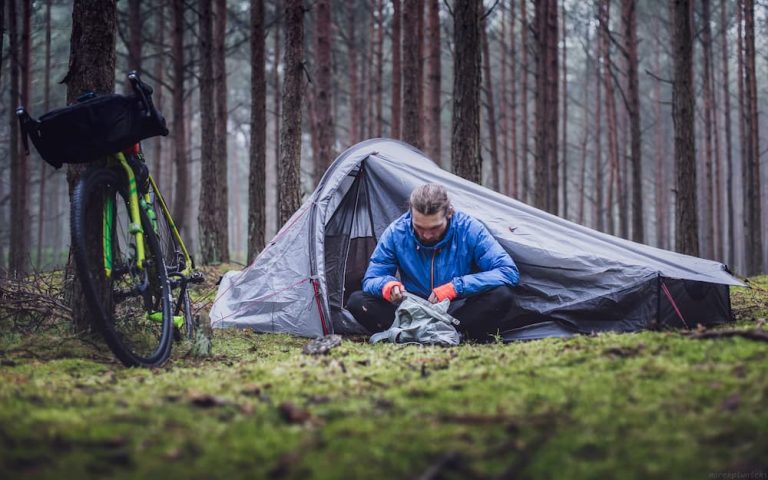How To Bring A Bike On A Plane?
Cycle touring around the world has taken up arms and how. Now more people are looking for convenient ways to find ways on how to take a bike on a plane.
While you may already know that traveling from one country to another or one city to another is no more a struggle than it used to be. Yet, a certain amount of fees, and regulations apply to all airlines and each carrier has its own set of rules.
Few airlines have made it mandatory to pack your bike up in a box or bag. Other carriers may charge an extra fee or include the additional baggage weight in how much is allowed.
Whichever way you want to use to carry your bike on a plane, you would have to follow a few important tips and generic steps to avoid unnecessary hassle.
As an Amazon Associate, I earn from qualifying purchases made through links in this post at no extra cost to you.
Contents
Taking a Bike on a Plane?
Before getting on with how to pack your bike for a flight, you would need to follow a few basic steps to begin with. Make a checklist or scheme through the following to make sure you have it all checked.
Step 1 – Check the rules
Once you have decided which airline to take, make confirmations on the rules and regulations followed by the particular airline. You can make a call to customer services for details.
You may want to know how much they charge for a bike, if they allow particular packaging systems and if baggage allowance is also an option.
Step 2 – Make a packing list
Make a comprehensive list of all tools and accessories you would need to start packing. This would also be necessary for flying without or without a bike.
Step 3 – Make sure your bicycle fits in the shipping box
Whether you decide to carry your bike in a box or bag, you would have to make sure you have got the correct dimensions of your bicycle. Make sure you measure out each part as the carrier size would be determined based on the bike size.
Step 4 – Take apart the bike and add padding
Disassemble the parts of your bike and add padding to the sharp edges of your bicycle before hauling them inside the box or bag. This especially helps cardboard boxes from getting damaged.
Step 5 – Pack the bike and lock the box
Secure and lock the bag. You may want to use specialized locks that have been approved by the Transportation Security Administration. In the case of bags, check all zips, buckles, straps and locks.
Packing Your Bike for a Flight
We want to specify that every bicycle cannot be packed the same way, although the basics would apply to both roads, as well as mountain bikes alike.
Likewise, it would also slightly vary on whether you are using a bike bag, box, or carrier that includes bike snapping accessories like duct tape and toe straps.
If the airline you are about to take a flight with provides you with a guideline, you would have to pack your bike by their rules. If not, the following is a more general guide to how to pack your bicycle when you’re on a flight:
Take Off the Bike’s Pedals, Saddle, and Seat Post
Pedals are among the bicycle parts that you would need to tape up and dispose of in one of your luggage securely. If you have a bag that has fringe pockets, go ahead and put it on them.
Taping in this step is important so it does not scratch the bags. Further, you’ll need to dismantle the saddle and seat post. For ease, you can remove the clamp completely and carry it separately.
Or you may decrease the seat post height and loosen the clamp if you do not have enough compartments to carry these separately.
Deflate and Detach the Bike’s Wheels
Undo the wheels of the bicycle, one by one at first before you deflate the tires to a certain extent. We recommend deflating the wheels in a way the rims are left unharmed even if the carriers carrying the wheels are unhanded or handled roughly.
Next, remove the skewer axle and put it securely in one of the bag pockets. You could also attach it to the bike’s spoke hub at the wheel’s center, using duct tape.
Separate the Rear Derailleur
Although many cyclists consider this an optional step of packing their bicycle, safeguarding the rear derailleur is important for proper shifting of the bike’s chain once you land at your tour spot.
Once you have taken off the rear merch, you may want to make sure the hanger bolt is tightened nicely. Many cyclists, on packing up their rear derailleur, complain about slapping chains once they take the mech off. For them, a wrap on the derailleur before securing it on the mudguard can help solve the problem.
Position the Handlebars, Cranks, Chain Rings
How you pack up your handlebar would depend on how big or small your bike bag or the box is. If you have less space, it’s best to let the stem of the handlebar be in its position while you tape it together with your head gears and fork.
If you have enough room in your bag to use, move the bar downwards and position the step to one side. Next, you may want to add some sort of padding protection to the top tube of the frame so that it becomes easy to cord and tie the stem to it.
For the chainring and crank, it is also important to add foam padding to avert unnecessary bike part damage.
Put It All Inside the Carrier
Finally, you would need to assemble it all in one pack. If you are carrying your bike in a bag with wheel sections, you would simply have to place the wheels on the compartments.
If your bag has a rigid base, you can place the bicycle in an upward position and if it’s a regular fabric surface bag, you’ll need to prop in the bike with the wheel turned up. Either you use a padlock or a zip tie to ensure that all is locked in and secured.
In case you are carrying your bicycle inside a box, there’s not much to do about the positioning of the bike. Place the bike, followed by the wheels on their position but separately. Protect the edges and corners of the box with paddings and tape the box up securely.
What Bag or Box to Use to Carry a Bike on a Plane?
Now that we have settled on how to pack your bicycle, we have a list of possible carriers in which you can bag it or box it all up. Since cost might a matter of concern for many, we’d like to recommend more than just a box and a bag.
Bike Bags for Planes
To take your bicycle on a plane, you could choose between a soft case bike bag, a hard case one, or one with both features, namely a hybrid bike bag.
Hard Case Bike Bag
Thule Round Trip Transition Bike CaseCHECK CURRENT PRICE
Nothing provides resistance against damage and the ultimate protection like a hard case bike bag. These bags are practically equipped with bomb-proof security and allow you to take everything together, with no exceptions in accessories and gear.
However, these bags are mostly heavy and can add significant costs to your baggage allowance. Boxes made of aluminum or hard plastic like Thule’s hard case box can take off some of that weight.
Soft Case Bike Bag
Evoc Bike Travel Bag ProCHECK CURRENT PRICE
Soft bike cases may not provide the same kind of protection but it would also make sure that other luggage is separated from its transit. These are lightweight, easy to carry, and make a great, hassle-free touring companion.
Plus, they fold down like a muffled towel for easy storage.
Soft bicycle cases with hard inner points are considered to be hybrids. These have rigid bases and paddings in all the edges and walls of the bag while offering a lightweight solution just like Evoc’s bike travel pro.
Bicycle Box for Flying
Before you consider shopping for a cardboard bike box from your familiar bike shop, you would have to make sure that the airline you’d be using does allow anything else than a dedicated bicycle bag on the flight.
This cheap alternative offers protection while letting you haul all the bicycle parts in one place but is inclined to be mishandled on transit.
You could add foam padding to corners where the bike might poke into the box and use duct tape to strap the box into one piece. Since the wheels of the bicycle have to be taken off, you’ll have to make sure that extra padding and protection are ensured for the rear derailleur and chain rings.
Since it’s a box, you should also make storage plans for this bike box at your travel destination. This would make your return journey with the bicycle box a lot easier if you have a place to store the box safely while you are touring.
CTC Plastic Bag
Like the possibility of carrying a bicycle box on a plane, you would also have to check with the airline authorities’ rules and regulations to make sure you can use a plastic bag to carry a bicycle on a plane.
This is hands down the most affordable and lightweight option to go with, and it makes it more convenient than most airlines accept a see-through plastic bag for reliability and comprising baggage weight. CTC plastic bags are compact and allow you to carry them around when you are on tour.
Many people prefer such bags because this bars them from dismantling every piece of the bicycle to be packed. We cannot say a CTC plastic bag would offer the same level of protection as a specialized bike bag or a box, but these bags are usually passed to the trolley and escape the possible damage on a conveyor belt.
How Much Does It Cost to Take a Bike on a Plane?
The cost of taking a bicycle on a plane would vary depending on several factors, but mostly the airline you have booked your flight in would play the most role in exceeding or limiting your baggage budget.
If you are looking to shop for a designated bike bag, a hard case or a soft case bike bag can cost from $400 to $700, depending on the brand, quality, and design. On the contrary, a CTC plastic bag would cost no more than $12 or $15.
if you wish to dismantle your bicycle and place it inside a bike box, double walled corrugated cardboard boxes offer the needed protection, that too at the affordable price of $20 to $30.
Airlines allow baggage weight to be between 50 lbs. to 100 lbs. United Airlines makes space for a 50 lbs. weight charging a fee of $150. Likewise, Delta Airlines charged $150 on baggage allowance, which they later eliminated on new rules and the fee came down to $30 to $40. However, Delta does not allow any bikes that are more than 100 lbs. in weight.
The cost of carrying a bicycle on any airline can vary from $50 to $200, with added cost for extra weight. You would also abide by the rules of what you can use to carry your bike in a place set by the carrier authorities.
Here are examples of transportation fees on domestic and international flights on several popular airlines.
| Airline | Los Angeles to Hawaii | Los Angeles to Miami | Los Angeles to Paris |
| United Airlines | $150 | $150 | $200 |
| Delta Airlines | $30- $40 | $30- $40 | $60 |
| SouthWest | $75 | $75 | $90 |
Final Thoughts
If you are a regular traveler getting on a plane with your bike for touring, you need to know how to carry a bicycle on a plane. Dismantling the bike, packing it all in, and adding extra paddings to ensure more security is all a lot of work and effort.
Designated bike bags add to the cost but aid in minimizing this struggle to make sure your bicycle is protected all the way. A cheaper alternative like a bike box or plastic bag is also feasible, only If the airlines’ regulation allows it.








